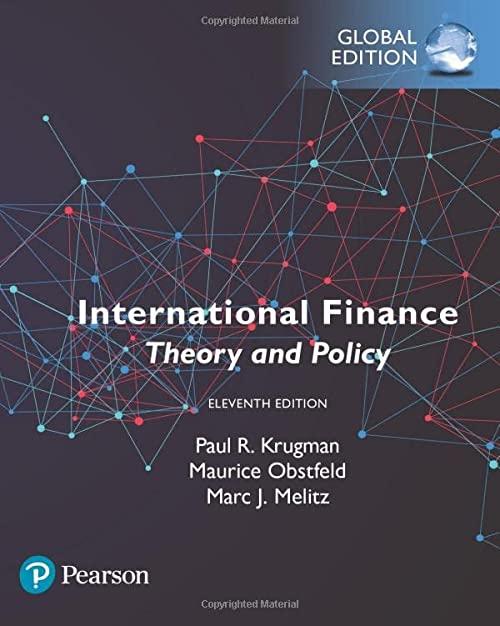Question
**Show in Excel** You are a financial analyst for the East Texas Manufacturing Company (ETMC). ETMC is studying the possibility of expanding its operations and
**Show in Excel**
You are a financial analyst for the East Texas Manufacturing Company (ETMC). ETMC is studying the possibility of expanding its operations and is considering two mutually exclusive approaches for doing so. Alternative A requires a smaller investment in plant and equipment with a significant workforce expansion. Alternative B entails a larger investment in plant and sophisticated technology, butdue to automationrequires less workforce expansion.
ETMC invested $200,000 in a feasibility study for this expansion, and its executives are somewhat confident that there is a significant market for its expansion, but there is clearly risk involved. Given the lower level of fixed costs of Alternative A, you have determined that this project has 10% less risk than an average project for ETMC. In contrast, given the higher fixed costs of Alternative B, you have determined that it is 20% more risky than an average project for ETMC.
Currently, ETMCs capital structure is as follows:
| Component | Description |
| Long-term Debt | $1000 par, 9% coupon bonds with 16 years until maturity. 10,000 bonds outstanding. Current market price of $1050.00.
Your investment bankers estimate that, at your investors current required rate of return, new bonds could be sold at par minus 5% flotation costs. |
| Preferred Stock | $100 par, 11% dividend preferred stock, currently selling for $110.00. 16,000 shares outstanding.
Your investment bankers estimate that ETMC could issue new preferred stock at par at your investors current required rate of return, but with a $2 per share discount and $3.75 per share flotation costs. |
| Common Stock | 200,000 outstanding shares, with a book value of $46 per share and a $68.00 current market price per share. Dividend history shown below.
Your investment bankers estimate that you could issue additional common stock shares with $2 per share underpricing and with flotation costs of $5.00 per share. |
| Year | Dividend |
| 2020 | $3.95 |
| 2019 | $3.76 |
| 2018 | $3.58 |
| 2017 | $3.41 |
| 2016 | $3.25 |
- Currently, the rate of return for the stock market is 9.9%, and the risk-free rate is 4.7%. ETMCs corporate beta is 1.35.
- ETMC is in the 24 percent tax bracket.
- ETMC uses a 4-year decision rule for the payback period.
Investment
If ETMC does not expand, it can sell the proposed expansion site for $500,000.
Alternative A requires an additional plant, equipment, and technology of $2,200,000. The plant, equipment, and technology are classified as MACRS 5-year property. The useful life of the equipment, however, is 7 years; at the conclusion of the 7-year period, it is estimated that the salvage value will be $250,000.
Under Alternative A, inventories will increase by $140,000, accounts receivable will increase by $135,000, and accounts payable will increase by $80,000.
Alternative B requires an additional plant, equipment, and technology of $6,100,000. The plant, equipment, and technology are classified as MACRS 5-year property. The useful life of the equipment, however, is 7 years; at the conclusion of the 7-year period, it is estimated that the salvage value will be $360,000.
Under Alternative B, inventories will increase by $180,000, accounts receivable will increase by $150,000, and accounts payable will increase by $85,000.
Revenues and Expenses
The following chart shows the expected revenues and operating costs for each project for each year.
| Alternative A | Alternative B |
| Year | Revenue | Operating Costs | Revenue | Operating Costs |
| 2021 | $1,100,000 | $510,000 | $1,700,000 | $380,000 |
| 2022 | $1,200,000 | $530,000 | $1,875,000 | $390,000 |
| 2023 | $1,300,000 | $560,000 | $1,975,000 | $400,000 |
| 2024 | $1,350,000 | $570,000 | $2,075,000 | $410,000 |
| 2025 | $1,250,000 | $585,000 | $2,150,000 | $420,000 |
| 2026 | $1,150,000 | $595,000 | $2,000,000 | $420,000 |
| 2027 | $1,050,000 | $600,000 | $1,800,000 | $425,000 |
Other Information
- In determining weights for the capital structure, you know that a market-value, target-weights capital structure is best. But when you asked the CFO what the target weights were, he said, we dont know. So, youll just have to do the next best thing rather than the best thing.
- In your finance courses at the university, you learned that the cost of equity can be estimated using Gordons Model or the CAPM. Do these two approaches come up with the same result? If not, which should you use for your analysis, and why?
- You have the information you need to use either non-risk-adjusted or risk-adjusted rates. Which should you use for your analysis, and why?
- You know that the required rate of return on retained earnings (rs) is less than the required rate of return on newly issued common stock (rncs). Your analysis of the financial condition of the firm, however, indicates that there is not sufficient cash being generated from retained earnings to finance either of these projects.
Your Assignment
With the information you have gathered, conduct a capital budgeting analysis using each of the appropriate decision rules. The companys top management will want to see your justification for your analysis, so you will need to show your work and explain your analysis and findings
Step by Step Solution
There are 3 Steps involved in it
Step: 1

Get Instant Access to Expert-Tailored Solutions
See step-by-step solutions with expert insights and AI powered tools for academic success
Step: 2

Step: 3

Ace Your Homework with AI
Get the answers you need in no time with our AI-driven, step-by-step assistance
Get Started


